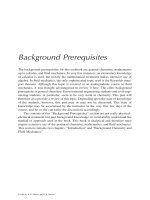Formats and Editions of Making sense of strategy_5 potx
Bạn đang xem bản rút gọn của tài liệu. Xem và tải ngay bản đầy đủ của tài liệu tại đây (173.57 KB, 11 trang )
product of flaky thinking as of poor execution. Strategies don’t have to be bril-
liant; they do need to make sense. Being radical is no substitute for being rigor-
ous; blend the two, and you’re most likely to have a winner.
THE BIG TEST
One strategy question underpins all others:
On what assumptions do you base your thinking?
This is the killer probe. Time and again, executives come off the rails right here,
because their assumptions are not clear—even to themselves. Yet they make asser-
tions as if they were facts:
“The economy will grow by 4 per cent this year.”
“Margins will definitely improve.”
“Our competitors are asleep.”
“Their only option is a price war.”
“No one is interested in this market; we have it to ourselves.”
“Our customers love us.”
“Our costs are the industry benchmark.”
“Our capabilities will let us compete anywhere.”
“We’re world class.”
But ask, “Do you know, or are you guessing?” and you’ll see they’re on shaky
ground. They don’t really know, they haven’t checked, and more often than not
they’re saying what they like to think or what they imagine you want to hear!
Many things in business are a mystery. You can never get enough informa-
tion, and often facts are slippery. What’s more, things change. So you can be
utterly certain of something today, only to find it untrue tomorrow.
process 57
The future is the greatest mystery of all. There is no way to know for sure
how it will evolve. Futurists have a terrible record.
1
They get things wrong more
often than they’re right.
Management is about making bets on the future. The question is, which future?
If hindsight is a perfect science, foresight is partly a matter of homework and
largely a matter of luck. Gathering facts, speculating, and creating scenarios is
no guarantee of success. Sometimes you’ll get it right and often you’ll be wrong.
It’s obviously important to know as much about your environment as you
can. Two frameworks bring order and discipline to the process and ensure that
you consider all issues that might matter (Figure 3-3). The first one focuses on
the drivers of competitive hostility in your domain. It looks at why the players
in that arena act the way they do and helps you anticipate what they might do
next. The second one gives you a more complete understanding of the world in
which you all operate. It helps you develop a fine-grained picture of your world
and the players and forces at work in it. And it asks a vital question: “Who gets
the value?” (If the answer is not you, start plotting some changes!)
Before you tackle the questions posed in either of these frameworks, you
need to draw a line around the business arena in which you work. Start with a
broad-brush view and then narrow down your target this way:
•
Industry. Some hip folk think it’s unfashionable to talk in terms of “industry”
(steel, motor assembly, bulk chemicals, retail banking), and prefer to talk
about “space” (as in, “We compete in the nutraceutical space”). There’s also a trend
toward thinking about “white space” (unoccupied territory) between industries.
These are hardly revolutionary ideas. You might well operate in two or more
industries at the same time, but say so. That way, analysts and other impor-
tant outsiders will know what you mean. (And you’ll know what you mean!)
58 making sense of strategy
No risk, no reward.
process 59
Figure 3-3 The best way to improve your chances of making a decent bet on the future is to have an in-depth
understanding of the world in which you compete. You need to understand both what causes competitors to
act the way they do and what’s happening in the macro arena.
TIMING &
SUSTAINABILITY
OF RETURNS
(Will we get
what we want?)
PERCEIVED
OPPORTUNITY
(What is it worth?)
AVAILABILITY OF
RESOURCES
(Have we got what
it takes?)
STRATEGIC
COMPLEXITY
(How difficult
will it be?)
COMPETITOR
INTENSITY
(Who, how many,
how aggressive,
how competent?)
DRIVERS OF
COMPETITIVE
HOSTILITY
Competitor intensity
Perceived
opportunity
Availability of
resources
Timing & sustainability
of returns
Strategic complexity
VALUE-ADDING
PROCESS
Innovation
Production
Marketing Logistics
Support Disposal
WHO GETS THE
VALUE?
KEY PLAYERS
Customers
Competitors
Complementors
Substitutes
Suppliers
MACRO CONTEXT
Economic
Political/legal
Social
Technology
Competitive
Customer
•
Geography. Where, exactly, on this planet do you compete—or intend to
compete? If you’re “going global,” which regions and countries will you
include? Which areas within them (provinces, cities, towns, communities)
will you concentrate on?
•
Product/customer category. Specify what you sell, and to whom (household
cleaner to career women, accounting software to small business, compo-
nents to auto makers). What want or need do you satisfy? Where are you on
the price scale? Do you provide “plain vanilla,” or all the bells and whistles?
How do people use your product or service?
•
Purchase and usage occasion. When do people buy and use your offering?
(If the buyer and the user are different, say so.)
•
Distribution method. What distribution channels do you use? Who controls
them?
The point of the exercise is to be clear about which turf concerns you and
which doesn’t. Doing this narrows your focus and lets you decide what you
must deal with and what you can ignore. The more specific you are, the better.
Beware, however, of being so neat and precise that you push potential com-
petitors—or other factors—off your radar screen. Threats and opportunities
come from unexpected places. If you’re not alert, you may not see them till it’s
too late.
(For example, if you sell clothing, your biggest competitor may be mobile
phones. If you sell cars, your customers’ service expectations may be shaped
not by other car companies but by airlines, restaurants, or the drycleaner down
the road. If you operate a chain of cinemas, your most serious challenge may be
from sports, PC games, downloaded music, or bookstores.)
No company can compete everywhere or be everything to everybody. You
need to understand your territory, not the whole map. And you have to balance
where you are now with where you want to be in the future.
You also have to decide how much information is “enough.” Most compa-
nies know less than they should about their environment. Some are junkies who
60 making sense of strategy
process 61
go overboard in their efforts to collect and analyze information. Effective lead-
ers know when to call a halt and say, “Move on!”
No matter how thorough you are, you’ll never take all the risk out of your
decisions or be sure you’re doing the right things. No amount of data gathering
or number crunching will guarantee success. The futurist has not been born
who can tell you what lies ahead. The best you can do is make an educated
guess. Time will tell whether you got it right or wrong.
Environmental scanning is not just an exercise to improve your understand-
ing of the world. It is not something to be done from time to time. And it is not
something that should be left to a few people.
These frameworks should be central to an ongoing conversation between as
many of your people as possible. By engaging many “scouts,” your chances of seeing
trends or shifts are greatly improved. Involving people in discussions about the
environment usually makes them realize they’re not happy with the status quo.
And participation makes them aware that there are many views of the world and
many possible futures—which prepares them to deal with a range of “tomorrows.”
This is a key activity in a continuous process of change and growth. It gives
you a good chance of seeing opportunities and problems early enough to act on
them. It is also a catalyst for change, in that when people think about the world
around them they almost always see the need for change. And it has a power-
ful educational effect, so it develops your team’s strategic IQ.
As you debate the issues in these frameworks, keep asking that crucial ques-
tion: “Do we know, or are we guessing?” And beware of letting assumptions
slide into your analysis disguised as truths. Fooling yourself may make you
comfortable in the short run, but sooner or later it will hurt you.
A SYSTEMATIC APPROACH TO PLANNING
Most strategic planning processes follow roughly the same path—and yield less
than satisfying results. Yesterday’s techniques are not likely to produce radical
TEAMFLY
Team-Fly
®
strategies. So here’s a new approach that gets you thinking about your organiza-
tion and its prospects in a more effective and practical way. It applies as much to
a startup venture as to an established business; as much to successful orga
nizations
that wish to stay that way as to troubled companies in need of critical care.
There are five building blocks (Figure 3-4). Each requires that you answer a
crucial question. Each of those, in turn, is answered through four further ques-
tions, which we’ll get to shortly.* Here are the big five:
1. Why do we exist?
2. How do we make money?
3. What kind or organization should we be?
4. What must we do, and how will we make it happen?
5. How will we win the support of our stakeholders?
62 making sense of strategy
Figure 3-4 Five questions give you a framework for thinking about your strategy. But, remember, you need to
know what’s happening around you as you make these decisions.
* The full list is on page 85.
1. Why do we exist?
2. How do we make money?
3. What kind of organization should
we be?
4. What must we do and how will we
make it happen?
5. How will we win the support of
our stakeholders?
PURPOSE
BUSINESS
RECIPE
ORGANIZATIONAL
CHARACTER
GOALS/PRIORITIES/
ACTIONS
STRATEGIC
CONVERSATION
process 63
The “strategy pyramid” produces the answers that analysts and investors want.
It guides you through a debate about where you intend to go and how. It also
helps you think about the kind of organization you need in order to achieve
your dreams.
STEP 1: DEFINE YOUR PURPOSE
Walk around almost any organization, and you’ll hear people at all levels ask-
ing questions like these:
“What are we trying to do?”
“Where is this company going?”
“What are the priorities?”
“What must I focus on?”
Senior executives don’t hear these concerns. Though only a few people at the
top know more or less what the company’s agenda is, they assume everyone
else does, too. And they often get irritated when confronted with these “idiot-
ic” questions. “That’s ridiculous!” they fume. “Aren’t they listening? What’s
wrong with people?”
Leadership is about providing direction. It’s also about shaping the context
in which people can make up their own minds, apply their own creativity, and
make effective decisions (a context, in other words, in which they are empowered).
If you could get away with a command-and-control style 20 or 30 years
ago, today you can’t. Environmental uncertainty, complexity, and accelerating
change make it a killer. Without lots of thinking people doing their own thing
and moving in roughly the same direction, your company just won’t progress.
When there’s confusion about direction, resources are wasted. Ad hoc
decision making becomes a way of life. People with too little information do
whatever seems smartest at the time, and they get it wrong a lot of the time.
Whatever strategy the bosses might have had in mind is ignored or quickly
overtaken and blown apart by events. The business’s agenda is decided in a
random and haphazard way—literally by accident.
Your business purpose answers the question “Why do we exist?” It’s
framed, in turn, by these four questions (Figure 3-5):
1. Whom do we serve? Who are your customers? What other stakeholders
must you consider? How do you rank them, so you know how to make
tradeoffs between their competing demands?
2. What value do we deliver? What do customers get from a relationship with
you? What products or services do you sell? What is your “difference”?
What do you do for stakeholders who are not customers?
3. Why do we matter? Why is your existence important to your stakeholders?
Why are they better off for having you around? Why should they support
you? What would it mean to them if you disappeared?
4. What is our ambition? Where are you headed? What are you striving for?
What do you want to achieve? By when?
Clearly, these questions are close to those that define a company’s vision and
mission. However, those terms have been badly abused and are too often con-
fused. By focusing on a single notion—your purpose—you get straight down to
business and to the decisions that will really make a difference.
64 making sense of strategy
Figure 3-5 Purpose provides direction and “stretch.”
WHOM DO WE
SERVE?
WHAT VALUE
DO WE DELIVER?
WHY DO WE MATTER?
WHAT IS OUR
AMBITION?
WHY DO WE EXIST?
STEP 2: DEFINE YOUR BUSINESS RECIPE
This is the area where companies come unstuck. Ask a team of managers sepa-
rately how they make money, and they will tell you different things. Ask peo-
ple elsewhere in the organization, and you’ll get many answers—or blank
stares. Ask, “Does all this make sense?” and the answer is usually “No!”
If your business recipe isn’t clear, you can’t expect your team to do the right
things. Nor will your stakeholders support you.
Again, four questions provide the direction you need (Figure 3-6):
1. What is our difference? What is your value proposition to customers? What
makes it unique? Why does it matter to them? (Think in terms of your com-
pany and its products and services; after all, customers buy the whole pack-
age.)
2. How do we deliver our value proposition? What business model underpins
it?
3. What makes our strategy superior? It’s too easy to say, “Of course we’re
best.” But why? What gives your strategy the edge when every competitor
thinks about roughly the same things, in much the same way . . . when they
all have access to similar capabilities and face the same constraints . . . and
when customers are increasingly smart and shopping around?
process 65
Figure 3-6 The business recipe explains growth.
WHAT IS OUR
“DIFFERENCE”?
(Value proposition)
HOW WILL WE DELIVER
OUR VALUE
PROPOSITION?
(Business model)
HOW DO WE CREATE & CAPTURE VALUE?
WHAT MAKES OUR
STRATEGY SUPERIOR?
HOW WILL IT
EVOLVE?
66 making sense of strategy
4. How will it evolve? A critical and usually overlooked question. Many
strategies work in the short term but quickly peter out or lead down a blind
alley. Executives commit resources without thinking about the move after
next. Best you talk about this up front so that, when you act, you do so with
a clear view of where you’re going.
DESIGN YOUR BUSINESS MODEL
The race for the future will be a race between competing business models.
Dotcom frenzy is driven by the imagination of entrepreneurs who cook up new
ways to sell everything from beans to banking. Yet established companies pay
surprisingly little attention to this issue.
As we saw in Chapter 1, companies experience life cycles because they
become good at doing something but keep doing it long after customers have
grown bored and gone shopping elsewhere. And, given that so many competi-
tors attack every opportunity, those life cycles are shrinking. Business models
become obsolete in no time at all. Today’s invaluable skills, technologies, and
processes can become tomorrow’s corporate killers.
Designing an effective business model requires that you think about the
value-adding potential of a number of key building blocks, both separately and
together. The 7Ps framework gives you a holistic view of your organization
(Figure 3-7).
2
It prompts you to think about factors that are easily overlooked,
yet that may be pivotal in creating and holding your competitive advantage.
As its name suggests, there are seven areas for inquiry. Your goal should be
to outperform your competitors in each of them. Add up enough positive dif-
ferences, and you’ll be hard to catch. You’ll gain even more advantage if you get
the seven elements to lock together, to reinforce one another into a whole that
is greater than the sum of the parts.
3
(The downside is that while it may be hard to change one part of your model
in the future, it’ll be even harder when they’re entwined. So the challenge is to
create a “tight” model—and at the same time to build in flexibility [Figure 3-8].
Once again, strategic conversation is a crucial factor.)
As with all the frameworks in this book, there are two ways to use this one.
One is to look at the way things are now, so you get a comprehensive picture of
your current business model—“Where we are today.” The other is to explore
possibilities for improvement and innovation—“Where we want to be tomor-
row.” And, of course, you can apply the framework in the same way to analyze
your competitors, to probe for differences between you and them, and to iden-
tify areas of opportunity.
process 67
Figure 3-7 The future of business will be dominated by a race for tomorrow’s business models. The 7Ps
framework gives you a comprehensive picture of your organization’s current health and provides a starting
point for thinking about new ways to compete.
PRODUCTS
PHILOSOPHIES
POSITIONING
PARTNERS
PURPOSE
PROCESSES
PEOPLE









